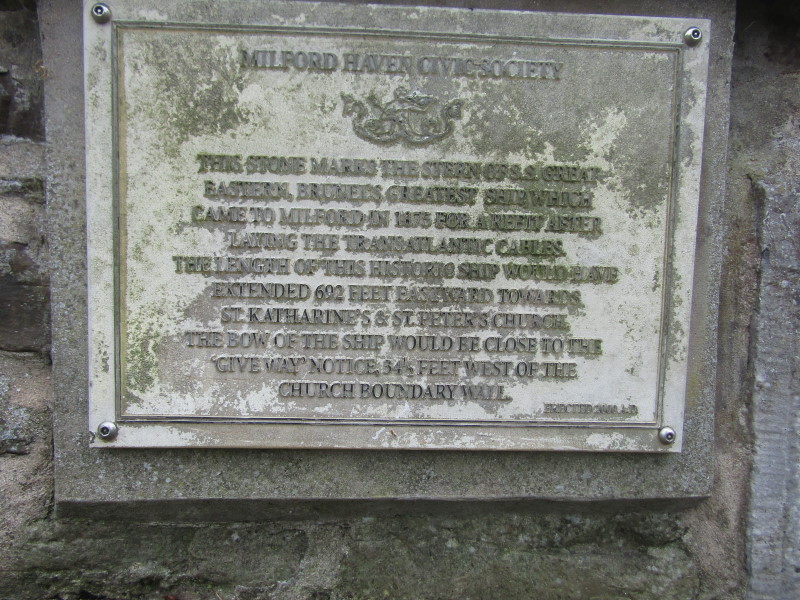The Great Eastern at Milford Haven
Isambard Kingdom Brunel (1806 to 1859) was one of the 19th century engineering giants who played a major role in the Industrial Revolution. He built dockyards, the Great Western Railway, three steamships that revolutionised naval engineering (SS Great Western in 1838, SS Great Britain in1843, and SS Great Eastern in 1859), and many important bridges and tunnels.
Brunel had many connections with Pembrokeshire beginning with the formation of the South Wales Railway Company in 1844 with Brunel appointed engineer. He was also engineer for the Great Western Railway and it was agreed that the latter would lease the South Wales line on its completion. The railway reached Haverfordwest on 28th December 1853. Brunel had in 1847 proposed that the railway should terminate at Abermawr on the St David’s Peninsula near Strumble Head, as a suitable deep water port for Ireland. Construction started there but was abandoned. Bunel’s ruins there can be visited today behind the beach. In 1851 Brunel decided to terminate the line at Neyland. The line opened in 1856 and connected with a new transatlantic terminal for ocean going ships.
One of Brunel’s aims was to connect London with New York. For this he now had the Great Western Railway with a terminal at Neyland. His last project was to connect them with a suitably great ship. For this he designed and built the SS Great Eastern. She was the largest ship ever built up to that time. She was 692 feet long and displaced 22,500 tons and she had sail, paddle wheels and screw propulsion. She was intended to carry 4,000 passengers across the Atlantic at one time without refuelling. She cost £732,000 – double the estimate. She was launched with difficulty on 31st January 1858. Brunel did not live long after her launch and without his guidance the great ship did not prosper as she might have done.
The Great Eastern first arrived at Milford Haven on Sunday 26th August 1860 on her return from her maiden voyage to New York. Her visit coincided with that of eleven warships of the Channel Fleet. Near Stack Rock, the Channel fleet was anchored in a double line, The navy ships greeted Brunel’s great commercial ship by the crews cheering and manning the rigging of their ships. The Great Eastern moored one mile below the Naval dockyard at Pembroke Dock. Thousands of sightseers turned up to view the ship and the Channel Fleet. There was insufficient accommodation for the visitors. The Great Eastern was moored at Neyland for six months for essential repair work. The ship earned much from crowds of visitors, many arrived by special trains. She set out on her second voyage to New York on 1st May 1861.
The Great Eastern returned to Milford Haven on 7th October 1861 for repairs. She had returned from a British Government charter to take troops to Canada carrying 2,144 officers and men, 473 women and children, 200 horses and 40 paying passengers. In 1861 through 1863 she made six more voyage to America operating out of Liverpool. But some of them proved financial losses. So in 1864 she was converted to a cable layer.
Between 1866 and 1875 she laid over 48,000 km of submarine cable. The transatlantic telegraph cable had presented a major logistical problem. The cable had a diameter of 1 inch and weighted 1 ton per two kilometers. A cable of 4,200 km (2600 miles) was needed. The only ship big enough to carry the cable was the Great Eastern. This she did in 1865. In 1862 a cable had been laid connecting a telegraph hut at Abermawr beach with Wexford. This led to the first transatlantic connection between London and New York. The telegraph hut remained in operation at Abermawr until 1922 or 1923 when the cable was washed away by a great storm. The hut is still there but is now a private home.
The Great Eastern then returned for the third and final time to Milford Haven in 1875. As she dropped anchor in Hubberston Roads, an artillery salute was fired. She was then moved to the partially-built Milford Docks. This gave publicity to the Docks to show that they could accommodate such a large ship. Two inscribed blocks of rock were inserted in the wall on Hamilton Terrace marking her length of 692 feet. She remained in the docks for the next five and a half years before being moved back to Hubberston Roads. She remained at anchor until 22nd April 1886 when she sailed for Liverpool. There she was sold for £16,000 for a crap and demolished with a ball and chain. In all she spent nearly eleven years in Milford Haven.
For visitors to Milford Haven a plaque to commemorate the visit of the Great Eastern can be seen on the wall below the railings along the seaward side of Hamilton Terrace. It is immediately above the Royal British Legion building near the red granite Belgian Monument at the top of Slip Hill. Its GPS position is lat. 51.711738 degrees N., long. 5.031899 degrees W. The plaque is shown in Figure 1. It reads:
‘Milford Haven Civic Society
This stone marks the stern of SS Great Eastern, Brunel’s greatest ship which came to Milford in 1875 for a refit after laying the transatlantic cables. The length of this historic ship would have extended 692 feet eastwards towards St. Katharine’s & St. Peter’s church. The bow of the ship would be close to the ‘Give Way’ notice, 34.5 feet west of the church boundary wall.’
There are two particularly good early photographs of the Great Eastern at Milford Haven. Both show the ship inside the partially competed Milford Haven Docks, alongside the site that was to become the fish market. As others own the copyright of these photographs, they cannot be show here. But a Google search for ‘Great Eastern, Milford Haven, Wales’ will easily find them.


